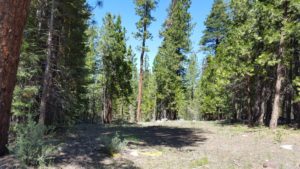 Diverse Southern Oregon forests have historically been dynamic landscapes shaped and maintained by fire. Large old trees and all sorts of forest fauna that depend on these landscapes are often the focus of restoration efforts that usually consider historical context as a good starting point. Restoring forests to historical landscape conditions, however, is an enormously nuanced and tricky business.
Diverse Southern Oregon forests have historically been dynamic landscapes shaped and maintained by fire. Large old trees and all sorts of forest fauna that depend on these landscapes are often the focus of restoration efforts that usually consider historical context as a good starting point. Restoring forests to historical landscape conditions, however, is an enormously nuanced and tricky business.
Forest scientists have been studying changes in density, tree size, and a number of other variables of around 100,000 forested acres near Chiloquin in Klamath County. They estimate that since the 1920s, the number of smaller ponderosa pine, white pine, and Douglas fir trees has increased six-fold across the study area.
Forecasts for future climatic conditions in Southern Oregon forests, like the Fremont-Winema National Forest, call for warmer temperatures, likely bringing more flammable conditions. Young trees compete with their elder neighbors for water and other resources – and if lost, old trees have a habit of taking an awful long time to replace. Considering this, thinning younger trees, what wildland fire scientists refer to as fuel ladders, in areas with large old ponderosa pines may be essential to preserving these irreplaceable forested landscapes.
“Historically, frequent fire strongly influenced this landscape, resulting in open-canopy ponderosa pine and mixed-conifer forests dominated by fire- and drought-tolerant trees,” said Keala Hagmann of Applegate Forestry in Corvallis in a recent Oregon State University press release.
Decades of fire suppression and other management activities in the region have allowed for uncharacteristically dense fuel conditions as smaller trees have filled in. “Large and old fire- and drought-tolerant trees are the structural backbone of dry, fire-prone forest ecosystems and make many unique contributions to ecological function,” said Hagmann. “If the remaining, substantially reduced population of large and old fire- and drought-tolerant trees are lost to fire, drought, or competitive stress, it would take centuries, if ever, to replace them and their ecological functions.”
However, management activities in these areas could also disturb peace and quiet for northern spotted owls, listed as threatened under the Endangered Species Act, which also reside in these forests.
“Northern spotted owl habitat, as measured by current metrics, was lacking historically, and the forest is now vulnerable to disturbance processes like fire and drought that historically maintained this area as predominantly open-canopy forest,” added Hagmann. “The analysis stems from fundamental questions about prioritizing single species management, even at-risk species, over forest restoration in areas where desired future conditions are consistent with historical conditions.”
With support from the Klamath Tribes and the U.S. Forest Service, researchers recently published their results as well as past and present inventory comparisons in Forest Ecology and Management.
View the original press release at http://oregonstate.edu/ua/ncs/
By Matthew Hunt
